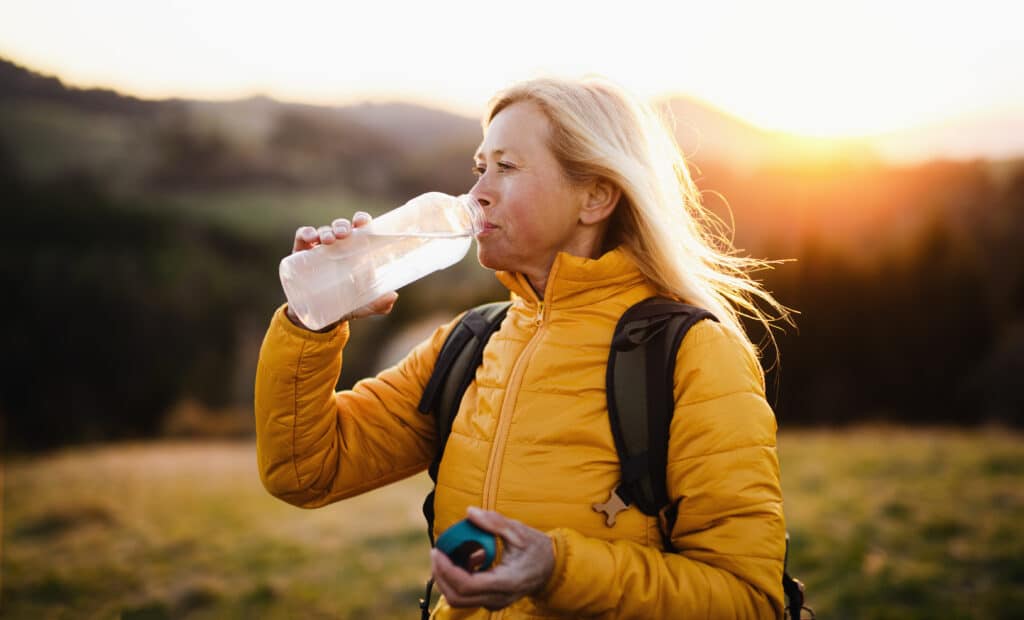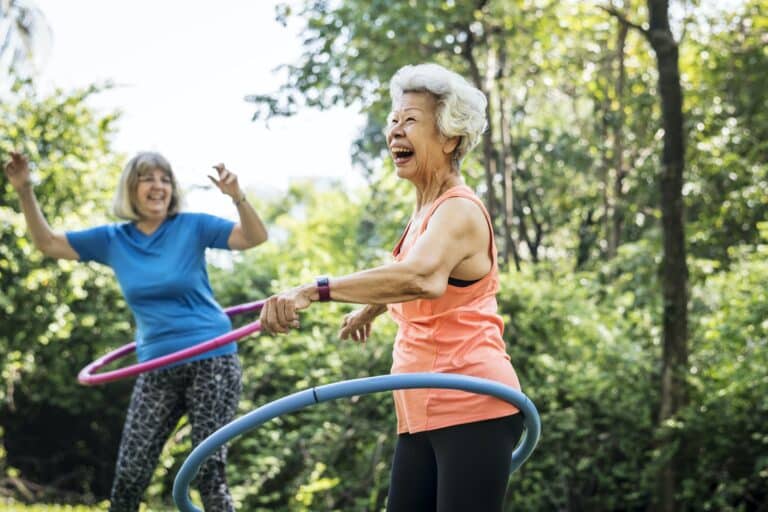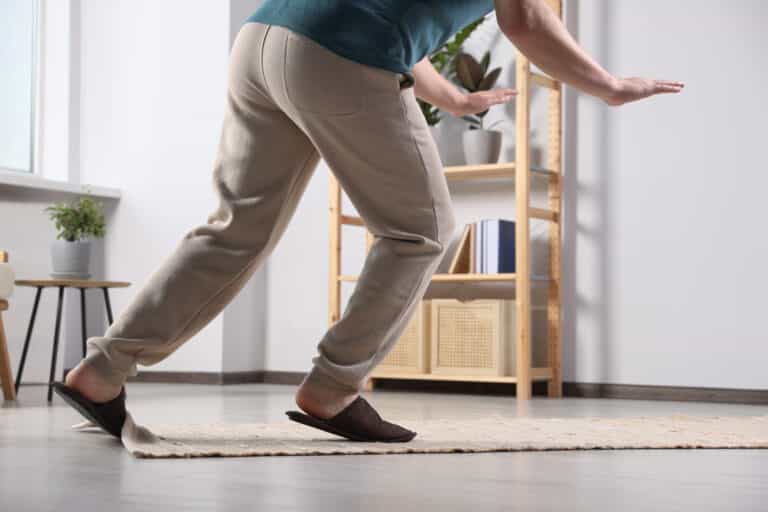For active adults, hydration is a critical aspect of health and well-being. But what causes dehydration? How long does it take to rehydrate? What signs should you look for that indicate dehydration?
Let’s dig into the science of hydration, strategies to prevent dehydration, and some practical tips to ensure you remain well-hydrated throughout your day.
Grab a glass of water as we explore the best ways to stay hydrated.
Understanding Dehydration
Dehydration is not just about feeling a little thirsty – it’s your body’s signal that it needs more fluids to function optimally. This can be particularly concerning for older adults due to age-related changes that affect our thirst mechanisms. In short, the risk of dehydration escalates as we age.
Our bodies are like well-tuned machines, signaling when they need something, and thirst is a prime example. When dehydrated, our bodies nudge us to drink fluids by making us feel thirsty.
However, the aging process can interfere with how our bodies signal thirst. Over time, our senses, like sight and hearing, tend to dull. Likewise, our body’s response to thirst isn’t quite as responsive as it might have once been. This means that even though our bodies might be parched, we may not feel as thirsty as we should. (1, 2)
This subtle shift in our thirst mechanisms can have significant implications. Older adults might not realize they’re becoming dehydrated until the situation escalates to severe dehydration.
This is why, for active adults, keeping a keen eye on hydration is crucial. It’s not just about responding to thirst but proactively ensuring we supply our bodies with the fluids they need to function at their best.
In simpler terms, the connection between thirst and hydration becomes unreliable as we age. As a result, older adults must adopt strategies prioritizing staying hydrated throughout the day, even if thirst signals might not be as robust as they once were.
How Long Does It Take to Rehydrate?
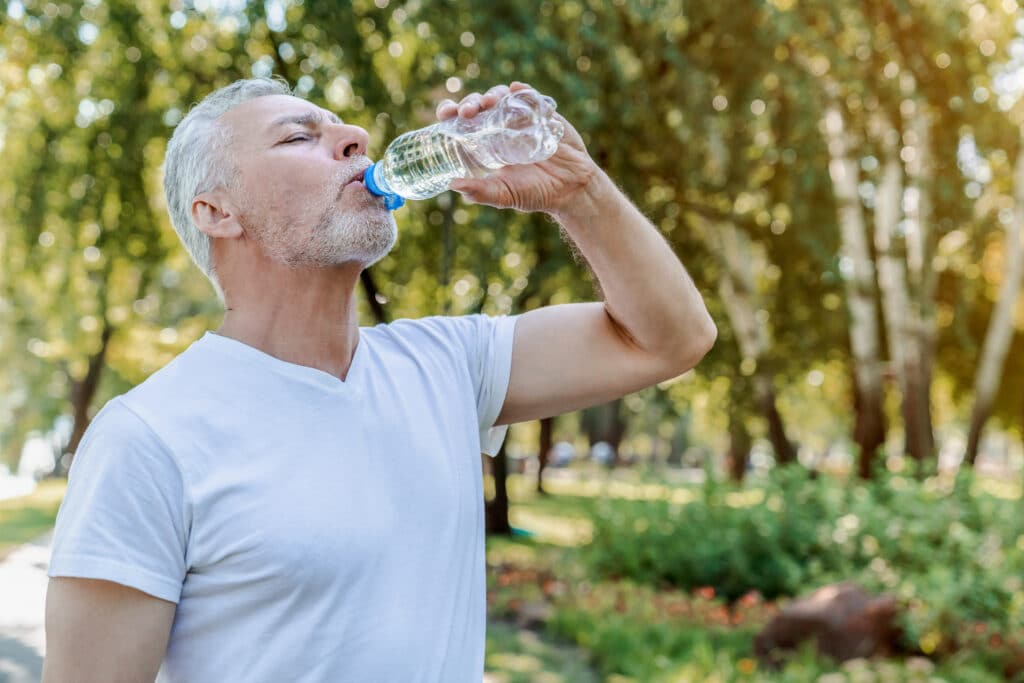
Rehydration is a process that occurs when the body replenishes lost fluids to restore its optimal balance. However, the speed at which this process happens is more than just a one-size-fits-all scenario. A combination of factors unique to each person influences rehydration. (1, 3)
The time it takes to rehydrate can vary based on several factors, including age, activity level, and the degree of dehydration. Some evidence suggests that older adults might experience slightly longer rehydration times compared to younger people.
Age plays a significant role in how quickly the body rehydrates. Specific physiological changes can impact the body’s fluid balance and absorption rate as we age. Research suggests that older adults might experience a slightly longer rehydration time compared to their younger counterparts.
The amount of physical activity you engage in can influence your fluid needs. If you’ve been active and sweating, you’ll likely need to rehydrate more quickly to replace the fluids lost through sweat.
For example, if you’ve been dehydrated for a day or longer, it may take longer to rehydrate.
How long you’ve been dehydrated makes a difference. Mild dehydration can be addressed relatively quickly, while it can take longer to rehydrate in more severe cases.
The type of fluids you consume also matters. Water is a fantastic go-to for rehydration, but beverages containing electrolytes can help replenish fluids and essential minerals lost during dehydration processes such as sweating.
Remember: each person’s body is unique, and factors like metabolism and overall health can influence how quickly you rehydrate.
Sip to Hydrate, Don’t Rush
You may be tempted to reach for a large glass of water and gulp it when thirsty. While this might quench your thirst momentarily, it’s not the most effective way to hydrate your body. In fact, it could even lead to discomfort.
Think of hydration as a marathon, not a sprint. Sipping water throughout the day allows your body to absorb and utilize the fluids more efficiently. This approach not only aids in rehydration but also helps maintain a more consistent fluid balance in the body over time.
So, let’s put down the water jug and pick up the teacup. Savor each sip, and remember that hydration is a mindful, ongoing process. Listen to your body’s signals and provide it with the fluids it needs to function at its best.
Common Signs of Dehydration
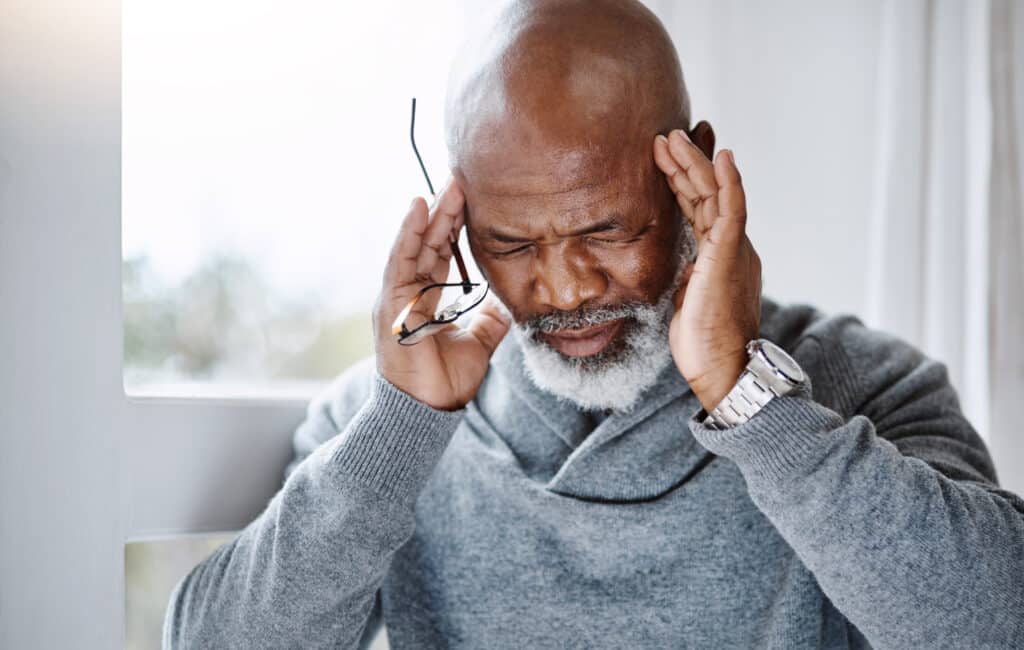
Here are some key indicators of dehydration to watch out for:
- Dry Mouth and Thirst: If your mouth feels dry, it’s time to reach for a glass of water. Starting your day with a glass of water is a great idea, especially since we often wake up with a dry mouth after not hydrating while we sleep.
- Urine Color: Your urine is a hydration barometer. Dark yellow or amber urine suggests dehydration, while pale yellow or straw-colored urine indicates you’re well hydrated.
- Fatigue: If you’re feeling unusually tired, it might not be just because of a late-night movie marathon. Dehydration can also lead to reduced energy levels.
- Dizziness: Feeling light-headed? It could be due to insufficient fluid intake, affecting blood pressure and circulation.
- Dry Skin: It might indicate dehydration if your skin feels uncomfortably dry. Dehydrated skin can feel dry, rough, or even itchy.
- Headache: Persistent headaches can be a sign of dehydration. Hydrating might help alleviate them.
- Muscle Cramps: If your muscles are cramping, especially during physical activity, it could be due to dehydration.
- Sunken Eyes: If your eyes look like you’ve been on a month-long desert trek, it’s time to hydrate. Sunken eyes or reduced tear production can be signs of dehydration.
- Confusion or Irritability: Dehydration can impact cognitive function and mood, leading to confusion, irritability, or difficulty concentrating.
Remember, staying hydrated is like keeping your car’s engine well-oiled. It’s not about filling the tank as fast as possible; it’s about maintaining a steady, consistent level. So, sip your water, listen to your body, and keep that engine running smoothly.
Steps for Preventing Dehydration
Staying hydrated is not just about quenching your thirst; it’s crucial to maintaining overall health, particularly for seniors. Let’s dive into some practical strategies to prevent dehydration and ensure your body gets the fluids it needs to function at its best.
- Set Personal Hydration Goals: Hydration is not a one-size-fits-all scenario. While the general guideline suggests around 8 cups (64 ounces) of fluids daily, your needs may vary based on activity level and climate. For instance, you may need to boost your fluid intake if you reside in an arid area with low humidity. A personalized hydration plan can help you stay on track.
- Embrace a Hydration-Friendly Diet: Hydration is not just about the fluids you drink; it’s also about the foods you consume. Foods rich in water content, like cucumbers, watermelon, and oranges, can significantly contribute to your hydration goals. Think of it as eating your water!
- Understand the Role of Electrolytes: Electrolytes, such as potassium, sodium, and magnesium, are vital for maintaining proper fluid balance within our cells and tissues. Incorporating electrolyte-rich foods like bananas, spinach, and yogurt into your diet can help keep your body hydrated. Electrolyte-rich beverages or supplements can also be beneficial, especially after physical activity.
- Keep a Reusable Water Bottle Handy: Carrying a reusable water bottle can make it easier to sip water throughout the day. Not only does this help you stay hydrated, but it’s also an eco-friendly choice!
- Pre-Hydrate: If you plan to engage in physical activity or spend time in a hot environment, pre-hydrate by drinking fluids beforehand. This preemptive action can help stave off dehydration.
The Best Way to Rehydrate
When you’re feeling parched, it’s tempting to gulp down a large glass of water. However, gradually rehydrating is more effective to avoid overwhelming your system. Sip on water throughout the day, and consider hydrating beverages like herbal teas and diluted fruit juices. Remember, caffeine from coffee or tea can have a diuretic effect, so moderation is key.
Life can get busy, and it’s easy to forget to drink enough water. Setting reminders on your phone or incorporating hydration breaks into your daily routine can help you stay on track. Remember, hydration is not a chore; it’s a healthy habit!
Staying active is fantastic for your health, but if you’re exercising, you must pay extra attention to your fluid intake. When you’re active, your body loses fluids more rapidly through sweat and breath.
Whether taking a leisurely stroll, practicing yoga, or working out in the gym, keep a water bottle handy and take frequent breaks to rehydrate. It’s much better to sip water throughout a workout than to drink more than your body can handle at the end.
Remember, staying hydrated is not just about drinking water; it’s about maintaining a balance of fluids and electrolytes in your body. So, let’s prioritize hydration and enjoy the benefits of a well-hydrated body!
Key Takeaways
- Staying hydrated is crucial for maintaining health and well-being throughout life.
- Age-related changes can affect how our body signals thirst, making it important for older adults to prioritize hydration even if they don’t feel as thirsty.
- Rehydration time varies based on age, activity level, and the extent of dehydration.
- Older adults might experience slightly longer rehydration times compared to younger individuals.
- Gradual rehydration by sipping water throughout the day is more effective than consuming large amounts at once.
- Recognize signs of dehydration, including dry mouth, dark urine, fatigue, dizziness, dry skin, headaches, muscle cramps, sunken eyes, and confusion.
- Prevent dehydration by setting daily hydration goals, incorporating hydrating foods, and carrying a reusable water bottle.
- Electrolytes are vital in maintaining fluid balance; include bananas and spinach in your diet.
- Hydrate before physical activity and during exposure to hot environments to prevent dehydration.
- Make hydration a habit by setting reminders and incorporating it into your daily routine.
References
- Beck, A. M., Seemer, J., Knudsen, A. W., & Munk, T. (2021). Narrative review of low-intake dehydration in older adults. Nutrients, 13(9), 3142.
- Stachenfeld, N. S., DiPietro, Nadel, E. R., & Mack, G. W. (1997). Mechanism of attenuated thirst in aging: role of central volume receptors. American Journal of Physiology-Regulatory, Integrative and Comparative Physiology, 272(1), R148-R157.
- Wotton, K., Crannitch, K., & Munt, R. (2008). Prevalence, risk factors and strategies to prevent dehydration in older adults. Contemporary nurse, 31(1), 44-56.
- Edmonds, C. J., Foglia, E., Booth, P., Fu, C. H., & Gardner, M. (2021). Dehydration in older people: A systematic review of the effects of dehydration on health outcomes, healthcare costs and cognitive performance. Archives of Gerontology and Geriatrics, 95, 104380.

